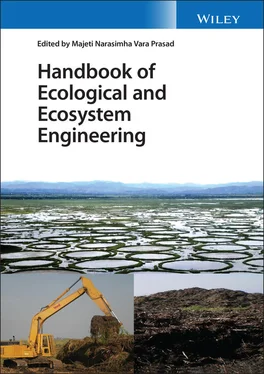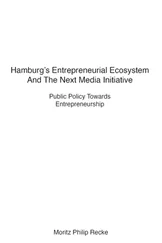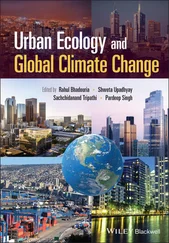Formal cause – the essence or nature of a thing
Material cause – the matter
Efficient cause –the source of change
Final cause – the goal or purpose
In general, the efficient causes of traditionally practiced engineering models are based on Newtonian‐mechanical approaches in the form of machine, design, and method. Societal as well as natural demands influence these approaches by material and formal causes. Material causes arise due to dependence on natural resources in terms of the extraction of raw materials and energy, while formal causes are based on the actual extraction of those materials from nature to meet societal demands. In this way, anthropocentric engineering design reflects societal norms: safety, welfare, and quality of life. Although the final cause may be a replication of societal overlap with nature, it primarily focuses on protecting the environment with nature‐preserving services and designs. Incorporating both organized simplicity and disorganized complexity in the four Aristotelian causes make traditional engineering designs advantageous. On the other hand, the Newtonian worldview covers the controlled development of elements, design of systems, and maintaining controlled conditions to serve and preserve societal needs. The ecological engineering worldview, design, system, and modeling have been successfully addressed by the Aristotelian four causes' scheme. However, the Newtonian approach has failed to reveal the nature of nature , indicating that it is an insufficient tool for designing the ecosystem [19].
Nature represents a self‐organizing, self‐sustaining system up to an exploitation threshold. Thus, any new approach must formulate a scheme to minimize external influence and also fulfill societal demands. Newtonian knowledge was found to be insufficient, and engineering science proved to be sufficiently efficient in developing the field of ecological engineering in terms of design concepts and management of the ecosystem. Gattie and Foutz [18] recognized the amalgamation of systems with engineering ecology as “the development, synthesis, and insight‐building of theory and principles from the fields of general systems science, systems ecology, and engineering, as they apply to making complex, holistic ecosystems, tractable study units of nature.” The foundation of traditional engineering has been built on the principles of engineering sciences; therefore, these principles must also be rigorously followed in the discipline of ecological engineering.
Before applying engineering concepts and theory to the ecosystem, the distinctive perceptions of ecosystem ecology and system ecology should be considered. The former is a discipline of measuring, quantifying, and tracing the flow of energy and materials via biotic as well as abiotic media of an ecosystem, while the latter defines the science of exploring the properties and functions of the ecosystem, which are known to mediate the energy and material flow within the entire system. Based on the principles and characteristics already mentioned, the following four proposed domains are relevant to the development of ecological engineering in terms of these two ecologies [19]:
1 Core system ecology theory
2 Ecological network analysis
3 Ecological modeling
4 System science
3.3 Practice and Implication of Ecological Engineering
A Newtonian approach alone may not be sufficient in formulating the design and principles of ecological engineering while framing a sustainable system. A balance between the domains of ecology, engineering, and design proposes a sustainable system model including an open living ecosystem that coexists with societal development. Traditional ecological knowledge 3 (TEK) and practices may prove to be revolutionary alternatives in generating thought‐provoking ideas for managing and restoring the environment by designing sustainable ecological engineering methods [2]. TEK has been practiced by indigenous and local populations to meet socioeconomic requirements since ancient times. With the integration of new techniques and concern about the environment, these practices have evolved over the years to ensure ecosystem sustainability and conservation. A World Commission on Environment and Development [62] report stated, “Local communities are the repositories of vast accumulations of traditional knowledge and experience that links humanity with its ancient origins. Their disappearance is a loss for the larger society, which could learn a great deal from their traditional skills in sustainably managing very complex ecological systems.” For more complex ecosystems with living and non‐living sections, a Newtonian worldview should embrace an organic approach to extend its boundaries. Traditional engineering, however, may not be successful in a natural system that depends on controlled distribution imposed on the environment and emergent behavior of the system during ecosystem management and design.
The practice of ecological engineering has been observed in various ecosystems with self‐design models and sustainability. Several large projects around the world have been designed based on these concepts: in the eastern part of the United States, restoration of salt marshes on Delaware Bay [45, 54]; river restoration in Jutland, Denmark, with farm and civilization protection [44]; reduction of nitrogen loading in the Gulf of Mexico [36]; restoration of Southeast Asian tropical mangroves [3]; and Mississippi River delta restoration [11, 12]. Mitsch [32] showed that well‐designed ecological engineering following oil spills in the Gulf of Mexico is more important than a traditional engineering approach that resulted only in wasting money and resulted in great harm to the ecosystem.
Practical approaches to ecological engineering are supported by programs and academic discussions. North American universities have developed several such programs: a separate environmental and ecological engineering department has been set up at Purdue University, Oregon State University has renamed its agricultural engineering department to biological and ecological engineering, and the University of Florida offers graduate‐level courses on ecological engineering. Other universities, such as the University of California Davis, Ohio State University, and McGill University, have special programs designed for students in this discipline.
3.4 Priority Areas for Ecological Engineering
The world population is growing rapidly and is expected to reach 10 billion by 2050 [5, 25]. With this accelerated population growth, exploitation of natural resources, fragmentation of land and water bodies, and extensive damage to ecosystems are inevitable consequences of urbanization and infrastructure development as a part of modern civilization. The prevailing processes of using non‐renewable natural resources and allochthonous energy inputs for long periods of time impose a future threat to the environment as a consequence of the exhaustion of these resources. Such resources are considered successful providers of energy and services due to their high calorific value. 4 Urbanization, on the other hand, is linked to artificial floods, drying up of water bodies, soil erosion, and pollution of all strata of the ecosystem; it ultimately leads to imbalances in the ecosystem, agricultural outputs, and ability to maintain the biodiversity of the planet. A balance between the natural ecosystem and ecosystem engineering services must be retained for the vitality of mankind. It is vital to identify key areas of conservation priorities and meticulously design ecological engineering services with ecological principles and rules to develop and manage structures that effectively enhance industrialization with a reduced impact on the environment.
Читать дальше












